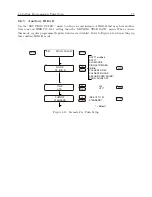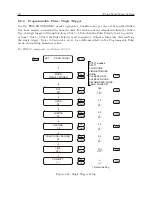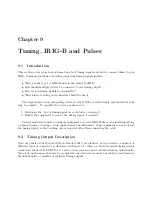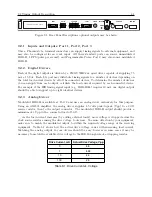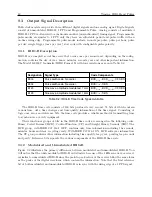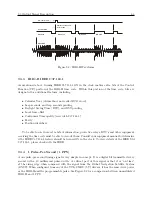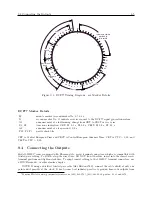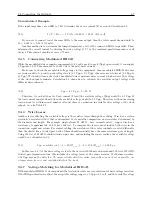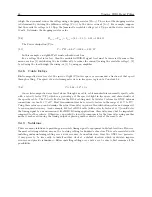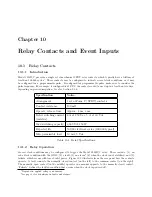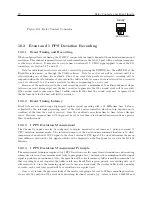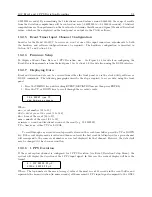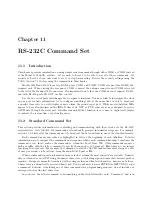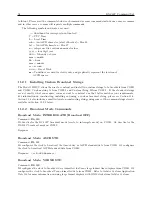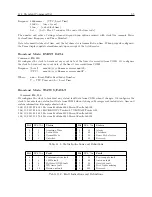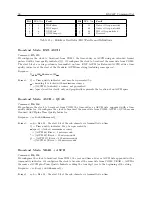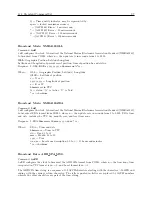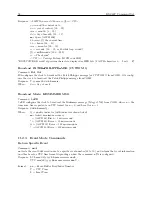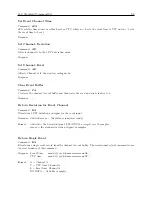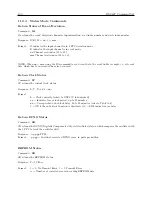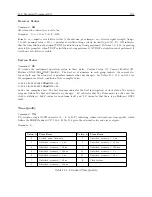
9.4 Connecting the Outputs
87
Unmodulated Example
If the input impedance of an IED is 5 kΩ, determine the device current (I) as seen in Calculation 9.1:
(9.1)
I
=
V
÷
R
dev
= 5
V olts
÷
5000 Ω = 0
.
001
A
(1
mA
)
If you were to connect ten of the same IED’s to the same output, then the total current drawn would be
10
×
0.001 A = 0.01 A (10 mA).
Another method is to determine the lumped impedance of all of the connected IED’s in parallel. Then,
determine the overall current by dividing the drive voltage (5 V) by the combined parallel impedance of all
devices. This current should not exceed 75 mA.
9.4.5
Connecting Modulated IRIG-B
While the modulated driver supplies approximately 4.5 volts peak-to-peak (Vpp) open circuit, it can supply
3 Vpp into 50 Ω. This amounts to about 0.06 A (60 mA) drive current.
Make sure to check the acceptable voltage range for the equipment. Some modulated IRIG-B decoders
are fairly sensitive to peak-to-peak voltage levels (3.3 Vpp
±
0.5 Vpp), others are more tolerant (0.1 Vpp to
10 Vpp). With added loads, the clock’s modulated driver produces more current, which reduces the voltage
at the clock output terminals. Calculation 9.2 shows how to calculate the available output voltage with
different drive currents.
(9.2)
V pp
= 4
.
5
V pp
−
I
×
20 Ω
Therefore, if you had 10 mA of load current (I load) the available voltage (Vpp) would be 4.3 Vpp. If
the load current equals 100 mA, then the available voltage would be 2.5 Vpp. Therefore, with an increasing
load current (i.e with increased number of loads) there is a reduction in available drive voltage at the clock
output. See also Table 9.1.
9.4.6
Wire Losses
Another factor affecting the available voltage is the resistive losses through the cabling. Wire has a certain
resistivity associated with it that is determined by its metallic composition, and resistance determined by
the diameter and length. For example, single-strand, 22 AWG – bare, enamel-coated – copper wire has a
resistance of approximately 19.6 Ω per 1000 feet. To compute the loss we must include both wires in the
connection, signal and return. For coaxial cabling, the resistance of the center conductor is rated differently
than the shield. For a twisted pair, both of them should essentially have the same resistance per cut length.
Using 500 feet of 22 AWG shielded twisted pair wire, and including the source resistor, the available voltage
would be as calculated in 9.3:
(9.3)
V pp available
= 4
.
5
−
I
×
20 (
R
source
)
−
I
×
19
.
6 (
R
wire
) = 0
.
54
V pp
In this case, 88 % of the drive voltage is lost to the device with 100 mA of current and 500 feet of 22 AWG
twisted pair transmission line; this includes the voltage losses at the source resistor. With some decoders,
0.54 Vpp may not be detected.
To assure reliable detection, make your cable runs as short as possible, use
a larger diameter wire and carefully distribute the loads.
9.4.7
Voltage Matching for Modulated IRIG-B
With modulated IRIG-B, it was mentioned that certain decoders are very intolerant of drive voltage variation.
If the IED specification says that the acceptable voltage range is 3.3 Vpp
±
0.5 volt, and the available voltage
Содержание 1201B
Страница 4: ...iv ...
Страница 153: ...B 7 Four Fiber Optic Outputs 135 Figure B 4 Jumper Locations ...
Страница 155: ...B 8 8 Channel High Drive IRIG B Amplifier 137 Figure B 5 8 High Drive Outputs Jumper Locations ...
Страница 171: ...B 10 Four Additional Outputs and Dry Contacts 25 50 Vdc 153 Figure B 7 Option Connector Signal Locations ...
Страница 222: ...Appendix E Statement of Compliance The following page is a statement of compliance that includes Model 1201B and 1201C ...



